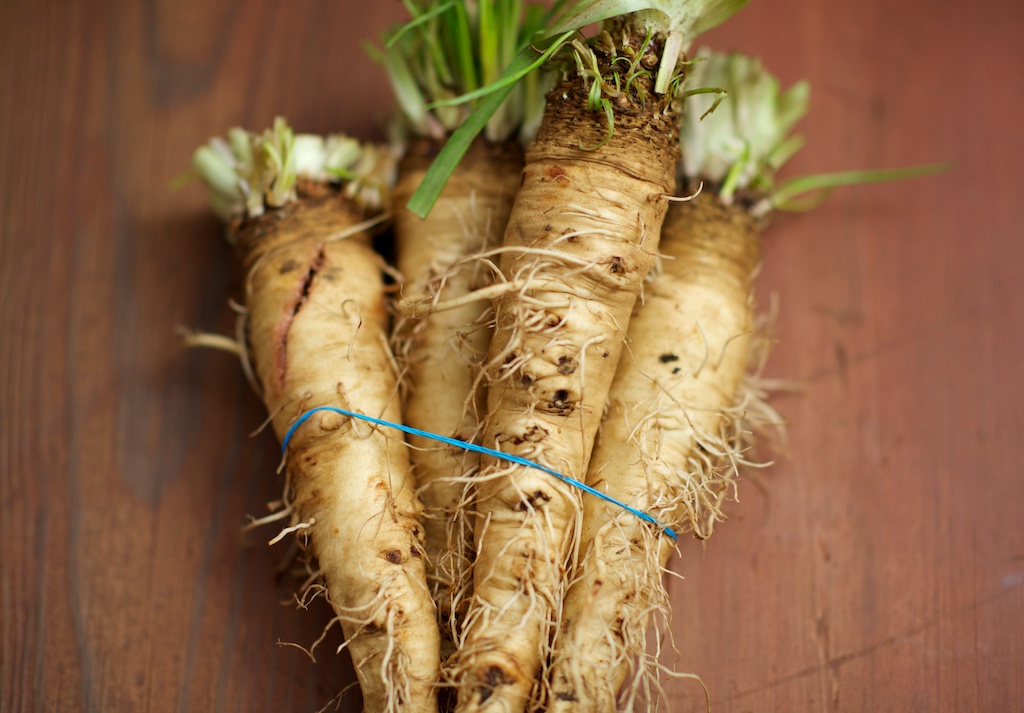Mar 11 2013
Fresh from the Market: Salsify

When salsify showed up in our CSA share a few months ago, I tucked a whiskery bunch of the vegetable into our bag with curiosity. While its name wasn't entirely unfamiliar to me, I had never cooked with this root vegetable before, and I knew that I needed to get home to do some research. My familiarity with salsify's name came from a distant memory of seeing rows of it at London's Borough Market. At the time, I spent about 5 minutes desperately trying to take an attractive picture of the long, black roots. My photo attempts failed, but with the addition of salsify to our CSA share, this memory suddenly became fresh again.

Last week, salsify returned to our share – this time by choice. For the past few weeks, Mudjoy has let us pre-select which items we want in our share, and I willingly checked the box beside salsify, forgoing more familiar vegetables. Why? I was enamored by its uniquely sweet and earthy taste, and wanted to try cooking with it in a different way.
What:
The salsify in these pictures is known alternatively as "Tragopogon Porrifolius", white salsify, or oyster plant. The thin, black salsify from my failed photos in London is called "Scorzonera Hispanic", or black salsify. Salsify is a member of the daisy family and grows wild in the Mediterranean. Europeans began to cultivate salsify in the 16th century, and salsify was a common root vegetable in the United States until the dawn of refrigeration.

Flavor Profile:
Most people think salsify has a strong oyster-like taste. I'd agree with that assessment, and also add that this root vegetable's earthy flavor is reminiscent of a sunchoke.
In the Kitchen:
If you find salsify at your farmers' market, choose roots that feel firm, ideally with their green tops still attached. Once home, you can store salsify in your refrigerator for up to 1 week, if kept in a bag. When ready to use, peel the root, including the whiskers, and slice salsify into coins, chunks, or matchsticks. Put the peeled salsify in a bowl of water with a bit of lemon juice to prevent them from discoloring prior to cooking. If you want to save water, you can just put the salsify in the water you plan on cooking it in (just omit the lemon juice!).
Salsify responds incredibly well to roasting or steaming. From there, you can turn them into fritters or a puree.


Growing Season:
Salsify seeds are directly sown in the Spring through Summer, as the roots need 120 to 150 days to reach harvest. The roots are harvested when they reach around 12 inches in length. Salsify tastes best when the roots come to maturity in cool weather.
Two Quick Ways to Cook with Salsify:
Roast the roots!
Adapted from The Garden Cookbook
Preheat your oven to 400ºF. Scrape the salsify to get rid of the hairy whiskers and cut into 1/2 inch rounds. If you have a lot of roots to cut, place the rounds directly into a bowl of water and squeeze a bit of lemon juice into the bowl. Then, once ready to roast, toss them with olive oil and thyme, and roast them until tender (roughly 30 minutes).

Puree the roots!
Adapted from River Cottage Veg Everyday
Peel the salsify (500 g) and chop the peeled roots into large chunks. Put the roots into a pan of water, with the water covering the roots by about 1/2 inch. Add salt, bring to a boil, and simmer for 15-20 minutes. Drain and reserve the cooking water. Transfer the salsify to a blender, add 30 g of butter, 3 tbs of heavy cream, a few thyme leaves, and a few twists of black pepper. Blend, adding a small amount of cooking water, if necessary.

